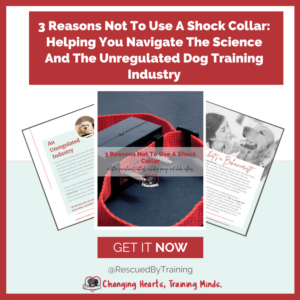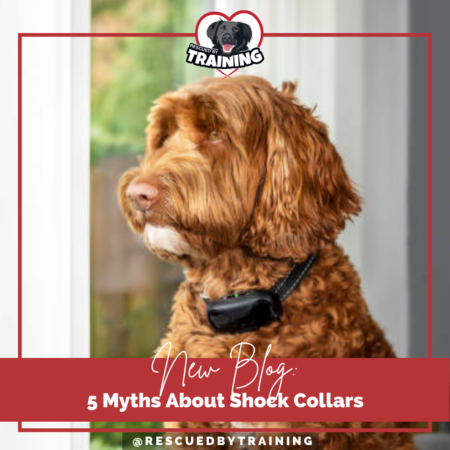I’ve written about why you shouldn’t use a shock collar and have my free download, 3 Reasons Not To Use A Shock Collar, but today I’m addressing some common shock collar myths. But, at its core, if you take nothing else away, it’s this:
Learning shouldn’t hurt.
We know there are better, more effective and more humane ways to train dogs. Many countries in the world ban the use of shock (and in some cases, prong collars also). France, Austria, Denmark, Germany, Norway, Portugal, Slovenia, Sweden, Switzerland, Wales, some parts of Australia, and the province of Quebec in Canada yet in the US, it’s still completely legal. There is a recent legislation being proposed in NY but widely in the US, shock collars are legal. In 2020 Petco became the first large scale retailer to stop selling remote controlled shock collars but still sells electric fence and containment systems.
There’s a lot of research on this topic, but a study published in the Journal of Veterinary Behavior, concluded “there is no credible scientific evidence to justify electronic collar use and the use of spray collars or electronic fences for dogs.” This study looked at the top 3 ways dogs are shocked in the name of training – remote controlled shock collars, anti-bark collars and electric fence/containment systems.
Let’s be clear. Let’s do away with the euphemisms. They’re not invisible. They’re not e-collars or pagers. They’re not a TENS unit. There’s no magic at play here. These things use electric current, with the intention of hurting or scaring your dog in an attempt to curb behavior. They are SUPPOSED to hurt. That’s how they work. Of course the marketing people won’t paint it like this, because no reasonable dog owner would be on board with hurting their dog intentionally.
So, let’s let’s dispel some myths about shock collars:
- They don’t hurt. This is the one aversive trainers love to say because they know that people who love their dogs wouldn’t intentionally hurt them. But, if they don’t hurt, how do they work? They must hurt enough to be aversive enough to stop the unwanted behavior. When we train we can use reinforcement or punishment. Those are the two types of motivators we have. If the dog isn’t being reinforced for behavior we want more of, then by definition they’re being punished to reduce behavior.
- It’s just like a TENS unit! This is untrue on multiple levels. First, even if you’ve “tried it” on yourself, a shock collar on your arm or other body part is not the same as a collar on a dog’s sensitive neck. Plus, if you’re “trying it” you are consenting and participating and aware of what is about to happen. Just like your participation in a TENS unit treatment is voluntary and you are aware of what is happening and can communicate to your provider if it is uncomfortable. Your dog has no such option to consent or not, doesn’t have control over when, for what or where they get shocked.
- It’s just a pager or way to “communicate.” Then why not use your voice? Why not train a verbal recall cue to come back when called? Shock collars are not leashes. If your dog doesn’t have a recall without a shock collar or being behind an invisible electric fence, then it shouldn’t be off-leash. This is a great post about why you should never use a shock collar for recall.
- I only use the beep or vibrate setting so it doesn’t hurt. A beep or vibration is not a reinforcer, like food is. No dog will respond to just a beep or vibration without having learned, even once, that a beep predicts pain from the shock. Words and noises have no meaning to dogs unless we train them to make a reliable association or they have a consequence. Animals, including dogs and humans are wired to avoid pain so avoiding pain can be single-event learning, meaning it only takes once for the animal to learn that if they repeat that action, pain will happen. This can make the animal fearful, afraid of future punishment or cause them to shut down behaviorally. As a child, you don’t touch a hot stove more than once. But we should not rely on or use fear of pain as a motivator to train dogs, or children.
- Other dogs wear them and they’re so calm and so well behaved! Dogs who live in fear of pain or fear of their owners (learning their owner causes the pain) often look like they’re “calm” or well-behaved, because they are afraid. Absence of normal dog behavior – dogs acting like dogs – is not healthy. I’ve previously written about The Myth of The Calm Dog. These dogs live in fear of making a mistake so often don’t do much of anything. Shock collars do nothing to teach dogs what to do that is right – it only punishes them after they’ve made a mistake.
And this brings me to a critical point, at least here in the US, which I have mentioned before. Dog training is an unregulated industry. You need more licensing to cut someone’s hair than you do to train a dog. Dog training is unregulated in the US. Not only does this mean consumers have no protection and anyone can do practically anything to your dog in the name of training, including hurting your dog, but it also means there’s a lot of muddy language around credentials and titles. Demand transparency and ask questions. There’s also recent legal filing against one of the manufacturers of a popular shock collar alleging they’re falsely marketed as safe. And San Francisco is leading the charge to be the first city in the US to entirely ban shock collars.
If you’ve fallen victim to predatory training methods or were convinced aversive methods are the solution, IT IS NOT YOUR FAULT. This is a symptom of an unregulated industry, with people posing as “professionals” with no recourse. But, you can change how you do things NOW.
“Do the best you can until you know better. Then when you know better, do better.” – Maya Angelou
So while some people turn to things like shock collars, thinking they will save money, we know from research that aversive methods can (and often do) result in increased fear, aggression, or learned helplessness, and fixing those long-term issues properly will cost you more money in the long-run, not to mention the emotional cost to your dog and the damage to your relationship with him.
For more about this topic, you can read these other posts where I’ve addressed the topic of Behavior Suppression Isn’t Behavior Modification, Fear Is Not Disobedience and that dogs very rarely “bite out of nowhere.” The common thread in these posts is behavior issues getting worse with punishment based methods of training.
 Interested in learning more? Download my free guide: 3 Reasons Not To Use A Shock Collar. I talk more about why not to use these tools, a deeper dive into regulation and give you citations to research if you’d like to look at it for yourself. You can also check out the Shock Free Coalition and sign the pledge to never use shock.
Interested in learning more? Download my free guide: 3 Reasons Not To Use A Shock Collar. I talk more about why not to use these tools, a deeper dive into regulation and give you citations to research if you’d like to look at it for yourself. You can also check out the Shock Free Coalition and sign the pledge to never use shock.
There are better, more humane, more effective ways to get results and I can help you. Contact me and schedule a session if you need help.
Happy training!
![]()




